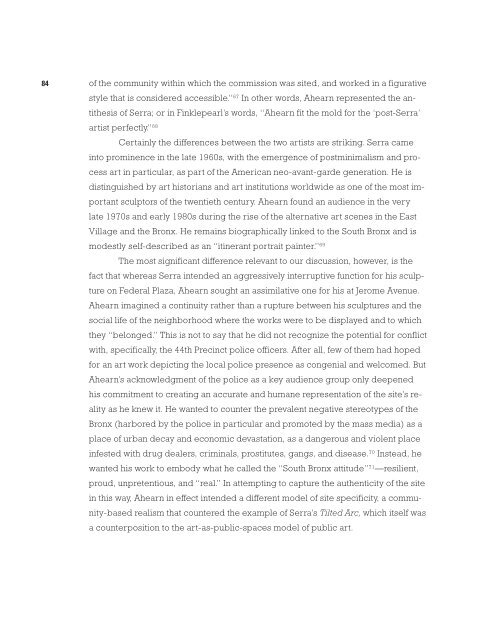ONE PLACE AFTER ANOTHER - Monoskop
ONE PLACE AFTER ANOTHER - Monoskop
ONE PLACE AFTER ANOTHER - Monoskop
Create successful ePaper yourself
Turn your PDF publications into a flip-book with our unique Google optimized e-Paper software.
84<br />
of the community within which the commission was sited, and worked in a figurative<br />
style that is considered accessible.” 67 In other words, Ahearn represented the antithesis<br />
of Serra; or in Finklepearl’s words, “Ahearn fit the mold for the ‘post-Serra’<br />
artist perfectly.” 68<br />
Certainly the differences between the two artists are striking. Serra came<br />
into prominence in the late 1960s, with the emergence of postminimalism and process<br />
art in particular, as part of the American neo-avant-garde generation. He is<br />
distinguished by art historians and art institutions worldwide as one of the most important<br />
sculptors of the twentieth century. Ahearn found an audience in the very<br />
late 1970s and early 1980s during the rise of the alternative art scenes in the East<br />
Village and the Bronx. He remains biographically linked to the South Bronx and is<br />
modestly self-described as an “itinerant portrait painter.” 69<br />
The most significant difference relevant to our discussion, however, is the<br />
fact that whereas Serra intended an aggressively interruptive function for his sculpture<br />
on Federal Plaza, Ahearn sought an assimilative one for his at Jerome Avenue.<br />
Ahearn imagined a continuity rather than a rupture between his sculptures and the<br />
social life of the neighborhood where the works were to be displayed and to which<br />
they “belonged.” This is not to say that he did not recognize the potential for conflict<br />
with, specifically, the 44th Precinct police officers. After all, few of them had hoped<br />
for an art work depicting the local police presence as congenial and welcomed. But<br />
Ahearn’s acknowledgment of the police as a key audience group only deepened<br />
his commitment to creating an accurate and humane representation of the site’s reality<br />
as he knew it. He wanted to counter the prevalent negative stereotypes of the<br />
Bronx (harbored by the police in particular and promoted by the mass media) as a<br />
place of urban decay and economic devastation, as a dangerous and violent place<br />
infested with drug dealers, criminals, prostitutes, gangs, and disease. 70 Instead, he<br />
wanted his work to embody what he called the “South Bronx attitude” 71 —resilient,<br />
proud, unpretentious, and “real.” In attempting to capture the authenticity of the site<br />
in this way, Ahearn in effect intended a different model of site specificity, a community-based<br />
realism that countered the example of Serra’s Tilted Arc, which itself was<br />
a counterposition to the art-as-public-spaces model of public art.

















